A Summary and Reflection on Endoparasites in Stray Animals Research
VerifiedAdded on 2023/06/12
|6
|1480
|370
Essay
AI Summary
This essay summarizes and reflects upon a research paper titled "Prevalence of endoparasites in stray and fostered dogs and cats in Northern Germany" by Becker et al. (2012). The essay focuses on the background, methods, results, and implications of the research. The study investigates the prevalence of endoparasites in stray and fostered cats and dogs from animal shelters in Northern Germany, highlighting that stray animals often carry more parasites due to lack of care and medical history. The methods included collecting fecal samples and using techniques like sedimentation flotation, IDEXX SNAP® Giardia test, Baermann technique, and the modified McMaster method for analysis. The results indicated that younger animals were more prone to certain infections, and Giardia spp. and T. cati were the most common parasites. The implications suggest a need for control strategies and further research on anthelmintic resistance. The reflection discusses the strengths and potential improvements of the original research, such as better literature support and clearer discussion of limitations.
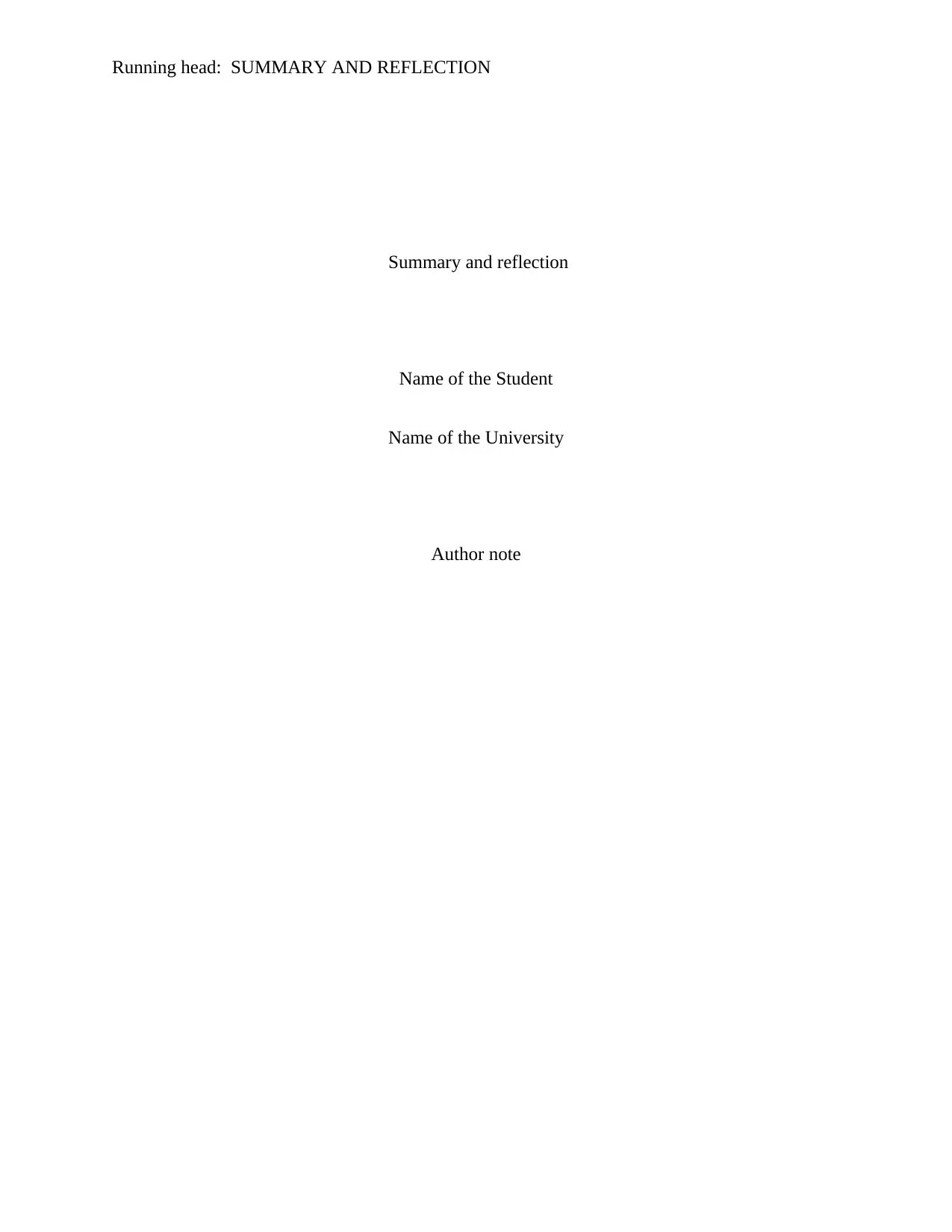
Running head: SUMMARY AND REFLECTION
Summary and reflection
Name of the Student
Name of the University
Author note
Summary and reflection
Name of the Student
Name of the University
Author note
Paraphrase This Document
Need a fresh take? Get an instant paraphrase of this document with our AI Paraphraser
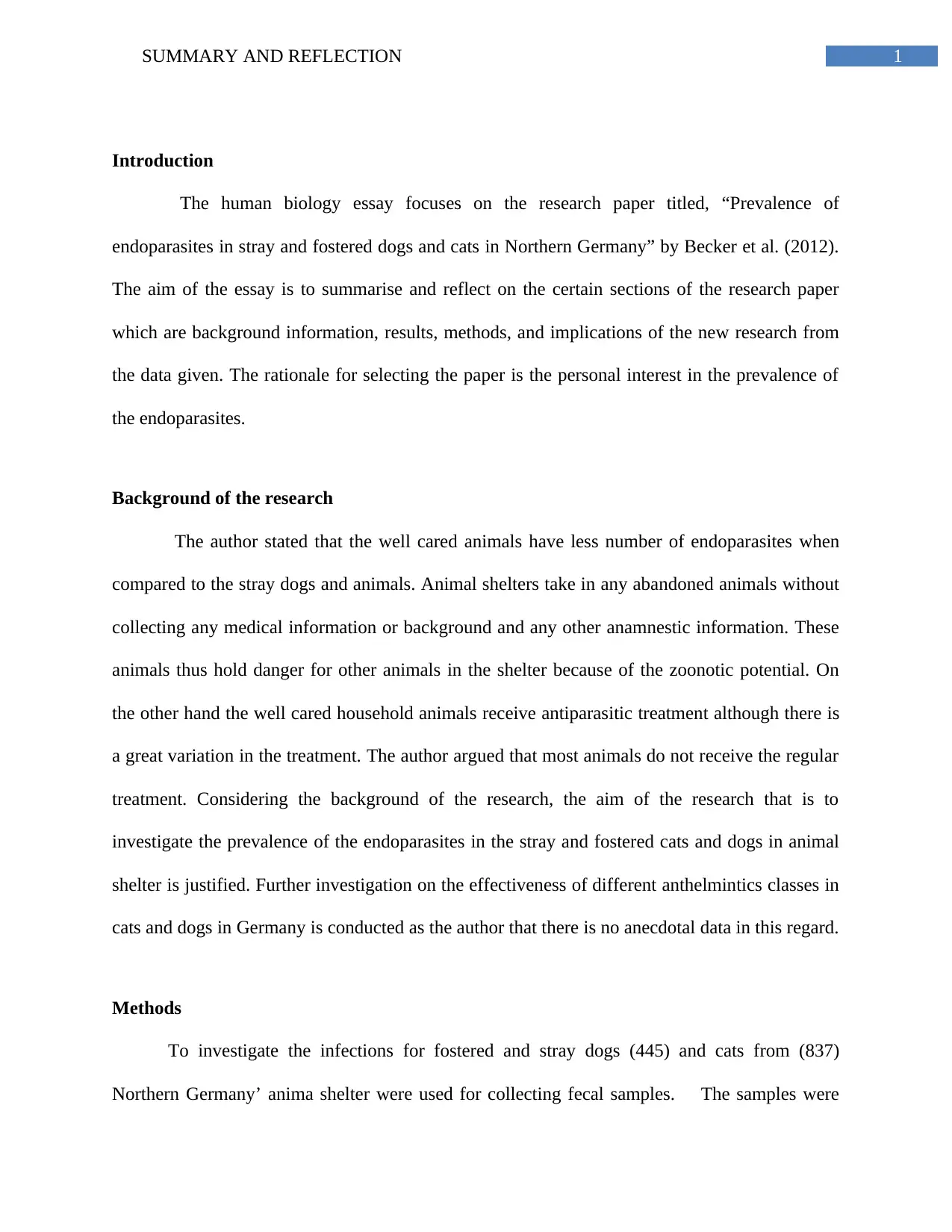
1SUMMARY AND REFLECTION
Introduction
The human biology essay focuses on the research paper titled, “Prevalence of
endoparasites in stray and fostered dogs and cats in Northern Germany” by Becker et al. (2012).
The aim of the essay is to summarise and reflect on the certain sections of the research paper
which are background information, results, methods, and implications of the new research from
the data given. The rationale for selecting the paper is the personal interest in the prevalence of
the endoparasites.
Background of the research
The author stated that the well cared animals have less number of endoparasites when
compared to the stray dogs and animals. Animal shelters take in any abandoned animals without
collecting any medical information or background and any other anamnestic information. These
animals thus hold danger for other animals in the shelter because of the zoonotic potential. On
the other hand the well cared household animals receive antiparasitic treatment although there is
a great variation in the treatment. The author argued that most animals do not receive the regular
treatment. Considering the background of the research, the aim of the research that is to
investigate the prevalence of the endoparasites in the stray and fostered cats and dogs in animal
shelter is justified. Further investigation on the effectiveness of different anthelmintics classes in
cats and dogs in Germany is conducted as the author that there is no anecdotal data in this regard.
Methods
To investigate the infections for fostered and stray dogs (445) and cats from (837)
Northern Germany’ anima shelter were used for collecting fecal samples. The samples were
Introduction
The human biology essay focuses on the research paper titled, “Prevalence of
endoparasites in stray and fostered dogs and cats in Northern Germany” by Becker et al. (2012).
The aim of the essay is to summarise and reflect on the certain sections of the research paper
which are background information, results, methods, and implications of the new research from
the data given. The rationale for selecting the paper is the personal interest in the prevalence of
the endoparasites.
Background of the research
The author stated that the well cared animals have less number of endoparasites when
compared to the stray dogs and animals. Animal shelters take in any abandoned animals without
collecting any medical information or background and any other anamnestic information. These
animals thus hold danger for other animals in the shelter because of the zoonotic potential. On
the other hand the well cared household animals receive antiparasitic treatment although there is
a great variation in the treatment. The author argued that most animals do not receive the regular
treatment. Considering the background of the research, the aim of the research that is to
investigate the prevalence of the endoparasites in the stray and fostered cats and dogs in animal
shelter is justified. Further investigation on the effectiveness of different anthelmintics classes in
cats and dogs in Germany is conducted as the author that there is no anecdotal data in this regard.
Methods
To investigate the infections for fostered and stray dogs (445) and cats from (837)
Northern Germany’ anima shelter were used for collecting fecal samples. The samples were
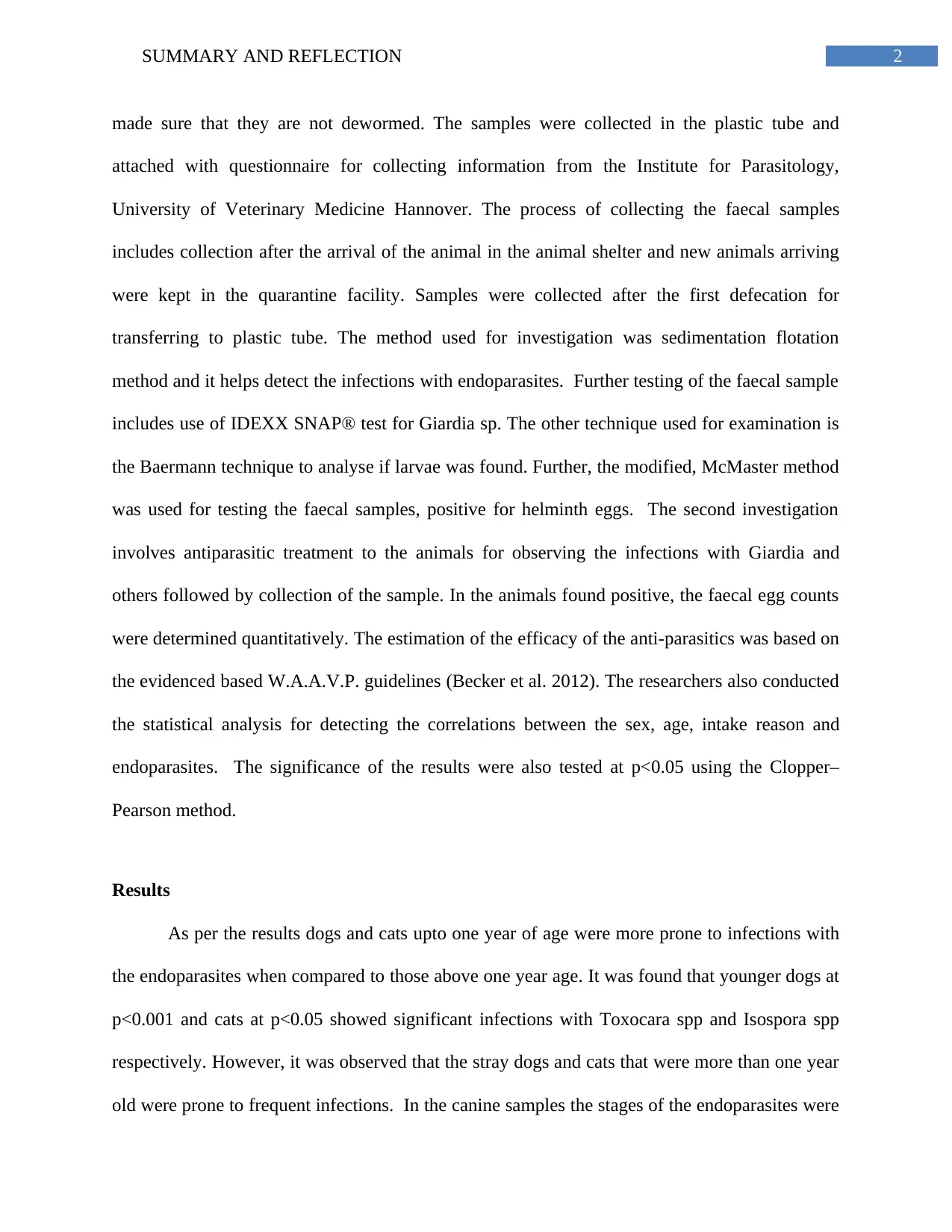
2SUMMARY AND REFLECTION
made sure that they are not dewormed. The samples were collected in the plastic tube and
attached with questionnaire for collecting information from the Institute for Parasitology,
University of Veterinary Medicine Hannover. The process of collecting the faecal samples
includes collection after the arrival of the animal in the animal shelter and new animals arriving
were kept in the quarantine facility. Samples were collected after the first defecation for
transferring to plastic tube. The method used for investigation was sedimentation flotation
method and it helps detect the infections with endoparasites. Further testing of the faecal sample
includes use of IDEXX SNAP® test for Giardia sp. The other technique used for examination is
the Baermann technique to analyse if larvae was found. Further, the modified, McMaster method
was used for testing the faecal samples, positive for helminth eggs. The second investigation
involves antiparasitic treatment to the animals for observing the infections with Giardia and
others followed by collection of the sample. In the animals found positive, the faecal egg counts
were determined quantitatively. The estimation of the efficacy of the anti-parasitics was based on
the evidenced based W.A.A.V.P. guidelines (Becker et al. 2012). The researchers also conducted
the statistical analysis for detecting the correlations between the sex, age, intake reason and
endoparasites. The significance of the results were also tested at p<0.05 using the Clopper–
Pearson method.
Results
As per the results dogs and cats upto one year of age were more prone to infections with
the endoparasites when compared to those above one year age. It was found that younger dogs at
p<0.001 and cats at p<0.05 showed significant infections with Toxocara spp and Isospora spp
respectively. However, it was observed that the stray dogs and cats that were more than one year
old were prone to frequent infections. In the canine samples the stages of the endoparasites were
made sure that they are not dewormed. The samples were collected in the plastic tube and
attached with questionnaire for collecting information from the Institute for Parasitology,
University of Veterinary Medicine Hannover. The process of collecting the faecal samples
includes collection after the arrival of the animal in the animal shelter and new animals arriving
were kept in the quarantine facility. Samples were collected after the first defecation for
transferring to plastic tube. The method used for investigation was sedimentation flotation
method and it helps detect the infections with endoparasites. Further testing of the faecal sample
includes use of IDEXX SNAP® test for Giardia sp. The other technique used for examination is
the Baermann technique to analyse if larvae was found. Further, the modified, McMaster method
was used for testing the faecal samples, positive for helminth eggs. The second investigation
involves antiparasitic treatment to the animals for observing the infections with Giardia and
others followed by collection of the sample. In the animals found positive, the faecal egg counts
were determined quantitatively. The estimation of the efficacy of the anti-parasitics was based on
the evidenced based W.A.A.V.P. guidelines (Becker et al. 2012). The researchers also conducted
the statistical analysis for detecting the correlations between the sex, age, intake reason and
endoparasites. The significance of the results were also tested at p<0.05 using the Clopper–
Pearson method.
Results
As per the results dogs and cats upto one year of age were more prone to infections with
the endoparasites when compared to those above one year age. It was found that younger dogs at
p<0.001 and cats at p<0.05 showed significant infections with Toxocara spp and Isospora spp
respectively. However, it was observed that the stray dogs and cats that were more than one year
old were prone to frequent infections. In the canine samples the stages of the endoparasites were
⊘ This is a preview!⊘
Do you want full access?
Subscribe today to unlock all pages.

Trusted by 1+ million students worldwide
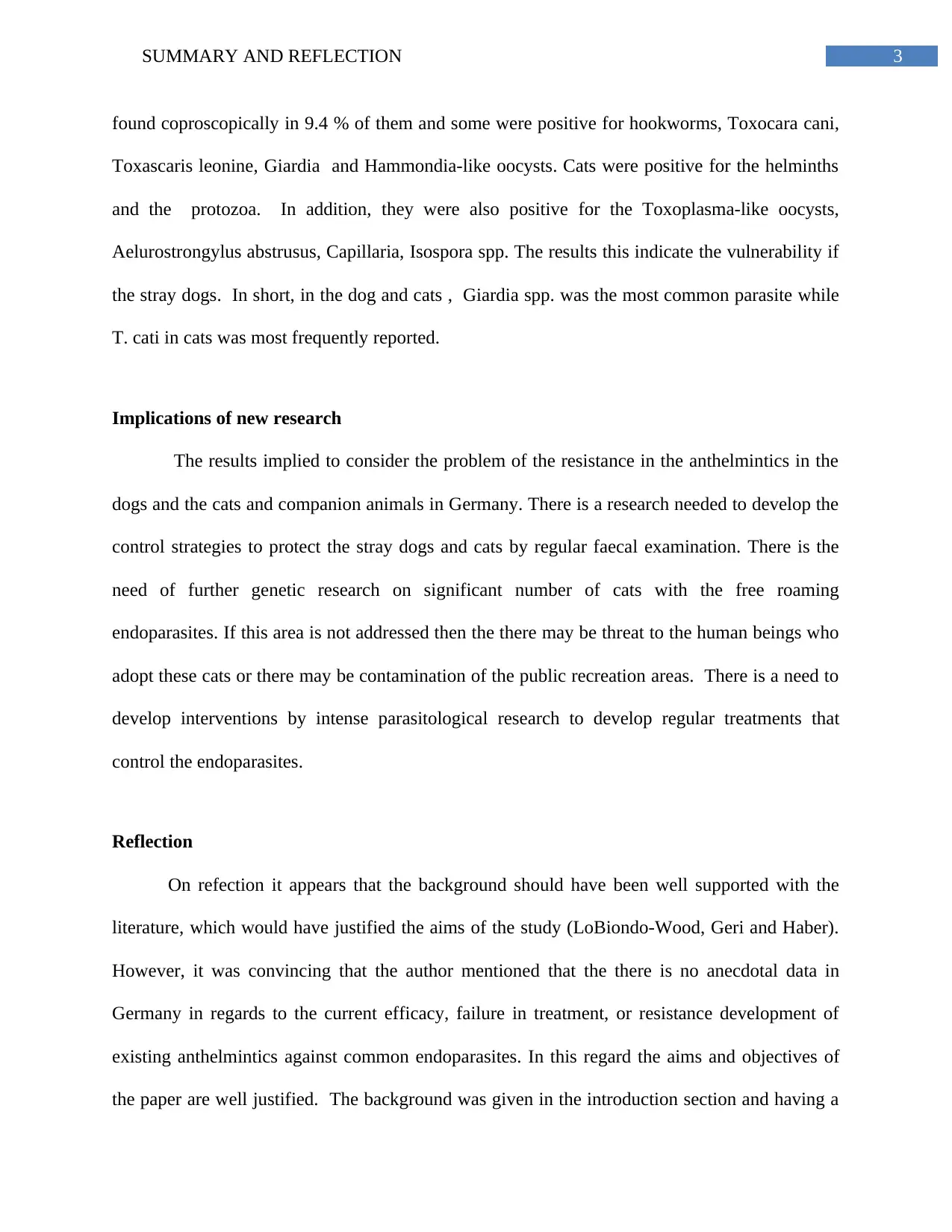
3SUMMARY AND REFLECTION
found coproscopically in 9.4 % of them and some were positive for hookworms, Toxocara cani,
Toxascaris leonine, Giardia and Hammondia-like oocysts. Cats were positive for the helminths
and the protozoa. In addition, they were also positive for the Toxoplasma-like oocysts,
Aelurostrongylus abstrusus, Capillaria, Isospora spp. The results this indicate the vulnerability if
the stray dogs. In short, in the dog and cats , Giardia spp. was the most common parasite while
T. cati in cats was most frequently reported.
Implications of new research
The results implied to consider the problem of the resistance in the anthelmintics in the
dogs and the cats and companion animals in Germany. There is a research needed to develop the
control strategies to protect the stray dogs and cats by regular faecal examination. There is the
need of further genetic research on significant number of cats with the free roaming
endoparasites. If this area is not addressed then the there may be threat to the human beings who
adopt these cats or there may be contamination of the public recreation areas. There is a need to
develop interventions by intense parasitological research to develop regular treatments that
control the endoparasites.
Reflection
On refection it appears that the background should have been well supported with the
literature, which would have justified the aims of the study (LoBiondo-Wood, Geri and Haber).
However, it was convincing that the author mentioned that the there is no anecdotal data in
Germany in regards to the current efficacy, failure in treatment, or resistance development of
existing anthelmintics against common endoparasites. In this regard the aims and objectives of
the paper are well justified. The background was given in the introduction section and having a
found coproscopically in 9.4 % of them and some were positive for hookworms, Toxocara cani,
Toxascaris leonine, Giardia and Hammondia-like oocysts. Cats were positive for the helminths
and the protozoa. In addition, they were also positive for the Toxoplasma-like oocysts,
Aelurostrongylus abstrusus, Capillaria, Isospora spp. The results this indicate the vulnerability if
the stray dogs. In short, in the dog and cats , Giardia spp. was the most common parasite while
T. cati in cats was most frequently reported.
Implications of new research
The results implied to consider the problem of the resistance in the anthelmintics in the
dogs and the cats and companion animals in Germany. There is a research needed to develop the
control strategies to protect the stray dogs and cats by regular faecal examination. There is the
need of further genetic research on significant number of cats with the free roaming
endoparasites. If this area is not addressed then the there may be threat to the human beings who
adopt these cats or there may be contamination of the public recreation areas. There is a need to
develop interventions by intense parasitological research to develop regular treatments that
control the endoparasites.
Reflection
On refection it appears that the background should have been well supported with the
literature, which would have justified the aims of the study (LoBiondo-Wood, Geri and Haber).
However, it was convincing that the author mentioned that the there is no anecdotal data in
Germany in regards to the current efficacy, failure in treatment, or resistance development of
existing anthelmintics against common endoparasites. In this regard the aims and objectives of
the paper are well justified. The background was given in the introduction section and having a
Paraphrase This Document
Need a fresh take? Get an instant paraphrase of this document with our AI Paraphraser
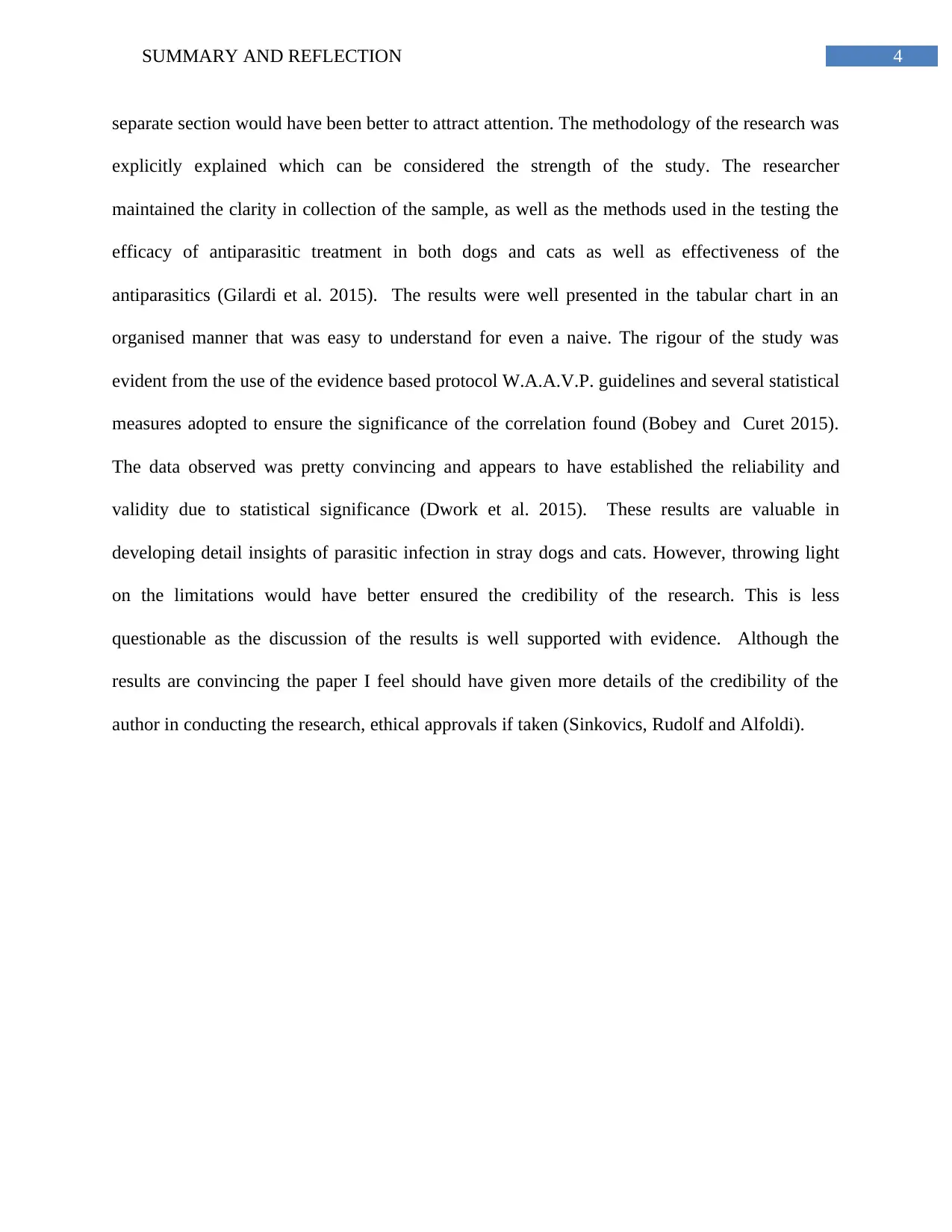
4SUMMARY AND REFLECTION
separate section would have been better to attract attention. The methodology of the research was
explicitly explained which can be considered the strength of the study. The researcher
maintained the clarity in collection of the sample, as well as the methods used in the testing the
efficacy of antiparasitic treatment in both dogs and cats as well as effectiveness of the
antiparasitics (Gilardi et al. 2015). The results were well presented in the tabular chart in an
organised manner that was easy to understand for even a naive. The rigour of the study was
evident from the use of the evidence based protocol W.A.A.V.P. guidelines and several statistical
measures adopted to ensure the significance of the correlation found (Bobey and Curet 2015).
The data observed was pretty convincing and appears to have established the reliability and
validity due to statistical significance (Dwork et al. 2015). These results are valuable in
developing detail insights of parasitic infection in stray dogs and cats. However, throwing light
on the limitations would have better ensured the credibility of the research. This is less
questionable as the discussion of the results is well supported with evidence. Although the
results are convincing the paper I feel should have given more details of the credibility of the
author in conducting the research, ethical approvals if taken (Sinkovics, Rudolf and Alfoldi).
separate section would have been better to attract attention. The methodology of the research was
explicitly explained which can be considered the strength of the study. The researcher
maintained the clarity in collection of the sample, as well as the methods used in the testing the
efficacy of antiparasitic treatment in both dogs and cats as well as effectiveness of the
antiparasitics (Gilardi et al. 2015). The results were well presented in the tabular chart in an
organised manner that was easy to understand for even a naive. The rigour of the study was
evident from the use of the evidence based protocol W.A.A.V.P. guidelines and several statistical
measures adopted to ensure the significance of the correlation found (Bobey and Curet 2015).
The data observed was pretty convincing and appears to have established the reliability and
validity due to statistical significance (Dwork et al. 2015). These results are valuable in
developing detail insights of parasitic infection in stray dogs and cats. However, throwing light
on the limitations would have better ensured the credibility of the research. This is less
questionable as the discussion of the results is well supported with evidence. Although the
results are convincing the paper I feel should have given more details of the credibility of the
author in conducting the research, ethical approvals if taken (Sinkovics, Rudolf and Alfoldi).
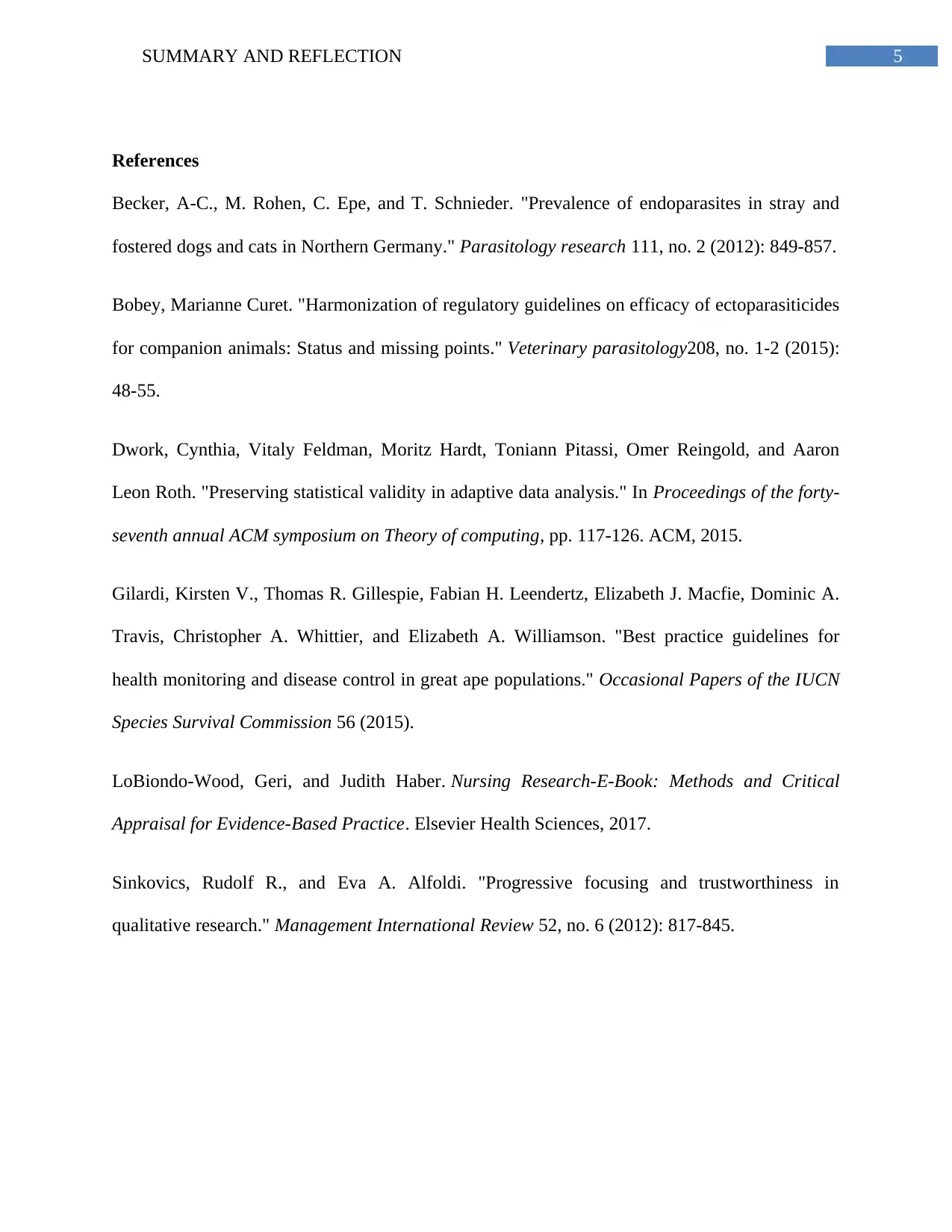
5SUMMARY AND REFLECTION
References
Becker, A-C., M. Rohen, C. Epe, and T. Schnieder. "Prevalence of endoparasites in stray and
fostered dogs and cats in Northern Germany." Parasitology research 111, no. 2 (2012): 849-857.
Bobey, Marianne Curet. "Harmonization of regulatory guidelines on efficacy of ectoparasiticides
for companion animals: Status and missing points." Veterinary parasitology208, no. 1-2 (2015):
48-55.
Dwork, Cynthia, Vitaly Feldman, Moritz Hardt, Toniann Pitassi, Omer Reingold, and Aaron
Leon Roth. "Preserving statistical validity in adaptive data analysis." In Proceedings of the forty-
seventh annual ACM symposium on Theory of computing, pp. 117-126. ACM, 2015.
Gilardi, Kirsten V., Thomas R. Gillespie, Fabian H. Leendertz, Elizabeth J. Macfie, Dominic A.
Travis, Christopher A. Whittier, and Elizabeth A. Williamson. "Best practice guidelines for
health monitoring and disease control in great ape populations." Occasional Papers of the IUCN
Species Survival Commission 56 (2015).
LoBiondo-Wood, Geri, and Judith Haber. Nursing Research-E-Book: Methods and Critical
Appraisal for Evidence-Based Practice. Elsevier Health Sciences, 2017.
Sinkovics, Rudolf R., and Eva A. Alfoldi. "Progressive focusing and trustworthiness in
qualitative research." Management International Review 52, no. 6 (2012): 817-845.
References
Becker, A-C., M. Rohen, C. Epe, and T. Schnieder. "Prevalence of endoparasites in stray and
fostered dogs and cats in Northern Germany." Parasitology research 111, no. 2 (2012): 849-857.
Bobey, Marianne Curet. "Harmonization of regulatory guidelines on efficacy of ectoparasiticides
for companion animals: Status and missing points." Veterinary parasitology208, no. 1-2 (2015):
48-55.
Dwork, Cynthia, Vitaly Feldman, Moritz Hardt, Toniann Pitassi, Omer Reingold, and Aaron
Leon Roth. "Preserving statistical validity in adaptive data analysis." In Proceedings of the forty-
seventh annual ACM symposium on Theory of computing, pp. 117-126. ACM, 2015.
Gilardi, Kirsten V., Thomas R. Gillespie, Fabian H. Leendertz, Elizabeth J. Macfie, Dominic A.
Travis, Christopher A. Whittier, and Elizabeth A. Williamson. "Best practice guidelines for
health monitoring and disease control in great ape populations." Occasional Papers of the IUCN
Species Survival Commission 56 (2015).
LoBiondo-Wood, Geri, and Judith Haber. Nursing Research-E-Book: Methods and Critical
Appraisal for Evidence-Based Practice. Elsevier Health Sciences, 2017.
Sinkovics, Rudolf R., and Eva A. Alfoldi. "Progressive focusing and trustworthiness in
qualitative research." Management International Review 52, no. 6 (2012): 817-845.
⊘ This is a preview!⊘
Do you want full access?
Subscribe today to unlock all pages.

Trusted by 1+ million students worldwide
1 out of 6
Your All-in-One AI-Powered Toolkit for Academic Success.
+13062052269
info@desklib.com
Available 24*7 on WhatsApp / Email
![[object Object]](/_next/static/media/star-bottom.7253800d.svg)
Unlock your academic potential
Copyright © 2020–2025 A2Z Services. All Rights Reserved. Developed and managed by ZUCOL.